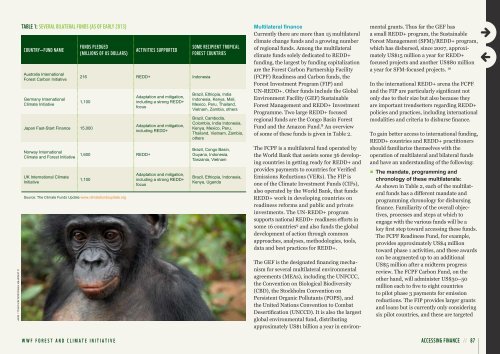WWF Guide to Building REDD+ Strategies
WWF Guide to Building REDD+ Strategies
WWF Guide to Building REDD+ Strategies
You also want an ePaper? Increase the reach of your titles
YUMPU automatically turns print PDFs into web optimized ePapers that Google loves.
© JENNIFER FERGUSON-MITCHELL / <strong>WWF</strong><br />
taBle 1: SeveRal BilateRal FundS (aS oF eaRly 2013)<br />
CountRy—Fund name<br />
Australia International<br />
Forest Carbon Initiative<br />
Germany International<br />
Climate Initiative<br />
FundS PledGed<br />
(millionS oF uS dollaRS)<br />
aCtivitieS SuPPoRted<br />
216 <strong>REDD+</strong> Indonesia<br />
1,100<br />
Japan Fast-Start Finance 15,000<br />
Norway International<br />
Climate and Forest Initiative<br />
UK International Climate<br />
Initiative<br />
1,600 <strong>REDD+</strong><br />
1,100<br />
Source: The Climate Funds Update www.climatefundsupdate.org<br />
<strong>WWF</strong> FOREST AND CLIMATE INITIATIVE<br />
Adaptation and mitigation,<br />
including a strong <strong>REDD+</strong><br />
focus<br />
Adaptation and mitigation,<br />
including <strong>REDD+</strong><br />
Adaptation and mitigation,<br />
including a strong <strong>REDD+</strong><br />
focus<br />
Some ReCiPient tRoPiCal<br />
FoReSt CountRieS<br />
Brazil, Ethiopia, India<br />
Indonesia, Kenya, Mali,<br />
Mexico, Peru, Thailand,<br />
Vietnam, Zambia, others<br />
Brazil, Cambodia,<br />
Colombia, India Indonesia,<br />
Kenya, Mexico, Peru,<br />
Thailand, Vietnam, Zambia,<br />
others<br />
Brazil, Congo Basin,<br />
Guyana, Indonesia,<br />
Tanzania, Vietnam<br />
Brazil, Ethiopia, Indonesia,<br />
Kenya, Uganda<br />
Multilateral finance<br />
Currently there are more than 15 multilateral<br />
climate change funds and a growing number<br />
of regional funds. Among the multilateral<br />
climate funds solely dedicated <strong>to</strong> <strong>REDD+</strong><br />
funding, the largest by funding capitalization<br />
are the Forest Carbon Partnership Facility<br />
(FCPF) Readiness and Carbon funds, the<br />
Forest Investment Program (FIP) and<br />
UN-<strong>REDD+</strong>. Other funds include the Global<br />
Environment Facility (GEF) Sustainable<br />
Forest Management and <strong>REDD+</strong> Investment<br />
Programme. Two large <strong>REDD+</strong> focused<br />
regional funds are the Congo Basin Forest<br />
Fund and the Amazon Fund. 8 An overview<br />
of some of these funds is given in Table 2.<br />
The FCPF is a multilateral fund operated by<br />
the World Bank that assists some 36 developing<br />
countries in getting ready for <strong>REDD+</strong> and<br />
provides payments <strong>to</strong> countries for Verified<br />
Emissions Reductions (VERs). The FIP is<br />
one of the Climate Investment Funds (CIFs),<br />
also operated by the World Bank, that funds<br />
<strong>REDD+</strong> work in developing countries on<br />
readiness reforms and public and private<br />
investments. The UN-<strong>REDD+</strong> program<br />
supports national <strong>REDD+</strong> readiness efforts in<br />
some 16 countries 9 and also funds the global<br />
development of action through common<br />
approaches, analyses, methodologies, <strong>to</strong>ols,<br />
data and best practices for <strong>REDD+</strong>.<br />
The GEF is the designated financing mechanism<br />
for several multilateral environmental<br />
agreements (MEAs), including the UNFCCC,<br />
the Convention on Biological Biodiversity<br />
(CBD), the S<strong>to</strong>ckholm Convention on<br />
Persistent Organic Pollutants (POPS), and<br />
the United Nations Convention <strong>to</strong> Combat<br />
Desertification (UNCCD). It is also the largest<br />
global environmental fund, distributing<br />
approximately US$1 billion a year in environ-<br />
mental grants. Thus far the GEF has<br />
a small <strong>REDD+</strong> program, the Sustainable<br />
Forest Management (SFM)/<strong>REDD+</strong> program,<br />
which has disbursed, since 2007, approximately<br />
US$15 million a year for <strong>REDD+</strong><br />
focused projects and another US$80 million<br />
a year for SFM-focused projects. 10<br />
In the international <strong>REDD+</strong> arena the FCPF<br />
and the FIP are particularly significant not<br />
only due <strong>to</strong> their size but also because they<br />
are important trendsetters regarding <strong>REDD+</strong><br />
policies and practices, including international<br />
modalities and criteria <strong>to</strong> disburse finance.<br />
To gain better access <strong>to</strong> international funding,<br />
<strong>REDD+</strong> countries and <strong>REDD+</strong> practitioners<br />
should familiarize themselves with the<br />
operation of multilateral and bilateral funds<br />
and have an understanding of the following:<br />
n The mandate, programming and<br />
chronology of these multilaterals:<br />
As shown in Table 2, each of the multilateral<br />
funds has a different mandate and<br />
programming chronology for disbursing<br />
finance. Familiarity of the overall objectives,<br />
processes and steps at which <strong>to</strong><br />
engage with the various funds will be a<br />
key first step <strong>to</strong>ward accessing these funds.<br />
The FCPF Readiness Fund, for example,<br />
provides approximately US$4 million<br />
<strong>to</strong>ward phase 1 activities, and these awards<br />
can be augmented up <strong>to</strong> an additional<br />
US$5 million after a midterm progress<br />
review. The FCPF Carbon Fund, on the<br />
other hand, will administer US$30–50<br />
million each <strong>to</strong> five <strong>to</strong> eight countries<br />
<strong>to</strong> pilot phase 3 payments for emission<br />
reductions. The FIP provides larger grants<br />
and loans but is currently only considering<br />
six pilot countries, and these are targeted<br />
aCCeSSinG FinanCe // 87

















